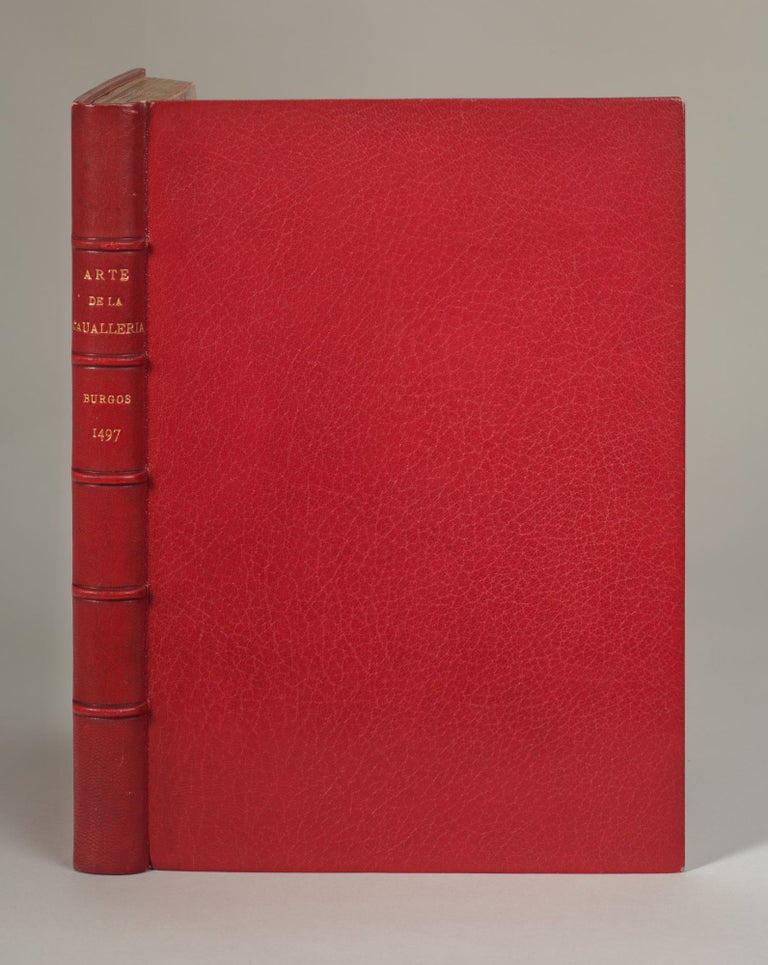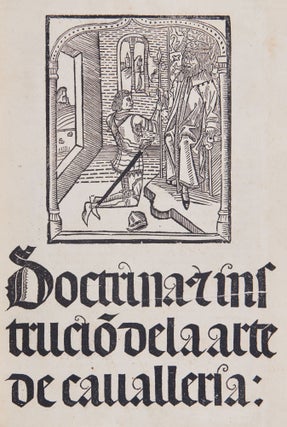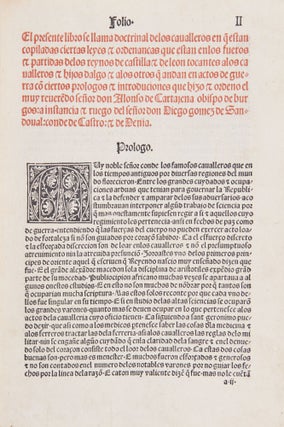Doctrinal instrucion de la arte de caualleria.
Burgos, Juan de Burgos 1497.
Folio (284 x 201 mm.). CXXVIII, [2] leaves. Gothic type.
XYLOGRAPHIC TITLE, FIRST USE OF THE LARGE WOODCUT OF A KNIGHT AND HIS ENTHRONED LORD (150 x 125 mm.); four-line floriated white- and black-line woodcut initials (a few printed guide letters), SECOND RECTO PRINTED IN RED AND BLACK with an eight-line white-line initial.
Jansenist crushed red morocco (Chambolle-Duru), gilt-lettered spine title, red morocco doublures with a gilt mask roll, two sets of marbled endleaves, all edges gilt, yellow and green silk marker.
“All that the noble needs to know can be found in the Doctrinal de los caualleros” (Fallows).
FIRST ILLUSTRATED EDITION and second overall. THIS IS ONE OF THE EARLIEST PRINTED THEORETICAL TREATISES ON CHIVALRY, the first indigenous to the Iberian peninsula and the most influential there through the 16th century.
Compiled in 1444, it served kings, queens, knights, jurists, clerics and military commanders IN CASTILLE, ARAGON AND THE NEW WORLD.
Broadly, it advocates national political consolidation and the expulsion of Muslims from the Iberian peninsula — both achieved by Isabella and Ferdinand, in 1469 and in 1492, respectively. Indeed, she inherited her manuscript Doctrinal from her father Juan II, and it formed an integral part of her education.
Specifically, the text codifies the knight’s obligations, privileges, rewards and punishments. It criticizes jousts and sword tourneys as vainglory, records their elaborate scoring systems and proves these exercises solely the prerogative of the formal military orders, like the Order of the Band (its rules given in full). The Doctrinal also enumerates the customary compensation (erecha) for battle wounds, from 5 maravedís (transfixed limb) to 50 maravedís (severed thumb, precluding further use of edged weapons) to 150 maravedís (death).
Juan de Burgos was the second, and first native, printer at Burgos. The two examples of this edition in the U.S. belonged to towering bibliophiles: Archer Huntington (Hispanic Society) and Lessing Rosenwald (Library of Congress).
A nice copy (extreme outer edge of two letters on the title invisibly restored), from the libraries of industrialist baron Achille Sellière (1813-73; Catalogue (1887) 22) and banker barone Horace Landau (1824-1903) with his bookplate. My thanks to Dr. Noel Fallows for his time and assistance.
¶Klebs, Incunabula scientifica et medica 47.2; Lyell, Early Book Illustration in Spain 88 & fig. 69; Fallows, The Chivalric Vision of Alfonso de Cartagena…the Doctrinal de los Caualleros; Almirante, Bibliografía militar de España 130-1; ISTC ia00537000; Goff A-537.
Sold



